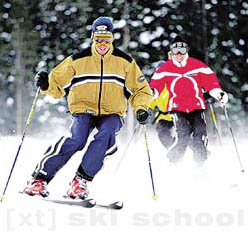|
Clothing: Staying Warm and Dry Dress comfortably and wisely
A word of advice for the beginner before the first outing -- clothing makes the person. Wear clothes that waterproof. You are going to spend a little time on the ground, and it's not very dry. And, if it's going to be snowing, you need goggles. Inversely, if it's sunny, bring your "slick-daddy" sunglasses. Consider wearing some long johns that are made from materials that wick perspiration away from the skin. If you get wet and cold, it's the double wammy -- you'll be in the lounge, disgusted and done for the day.
Ski clothing is a work of technological wonder. Every year manufactures come out with better fabrics and color schemes. The one important thing to consider when purchasing is weatherability. Look for fabrics that breathe, yet won't allow the perspiration to stay on the skin. A good polypropylene undergarment should be the first consideration, while the outer garments should be lightweight so you can layer additional clothing if needed. If it's hot out, you can simply take off the under layering sweater and the outer shell will be enough. But inversely, if it's cold, the adding of undergarments can give the needed warmth.
Look for ski specific clothing like the ones found in the ski shop. Yes, they cost a lot, but the functionality of the clothing will insure your warmth all day. You could go the route of non-brand names, but make sure the clothing is breathable. Most of the cheaper winter clothing on the market is made of waterproof material that will act like a weight-reduction rubber sweat suit making you break into an immediate sweat. That sweat will make the body cold and damp thereby effectively ruining your ski day.
Socks should be warm, but not thick and heavy. You don't want to add to much bulk and cut out the sensitivity of the feet. Consider this: ski racers wear only very thin socks, so they can feel the snow/ski reactions. Many of the better brand socks are made of polypropylene and keep the foot warm while keeping sensitivity high.
Pants should not be tucked into the boot. Remember, the shin needs to be pushed against the cuff of the boot for control, and if the pant leg is bunched into the boot, the result will be pain. Look for pants that have an internal powder cuff that can be velcrowed or snapped shut around the ankle sealing the snow out.
Alpine Skiing School section in english version of WWW.SKI.BG is based on
"A Guide To Becoming An Expert: From First Time To A Lifetime"
by John Mukavitz Copyright © 1998

|


